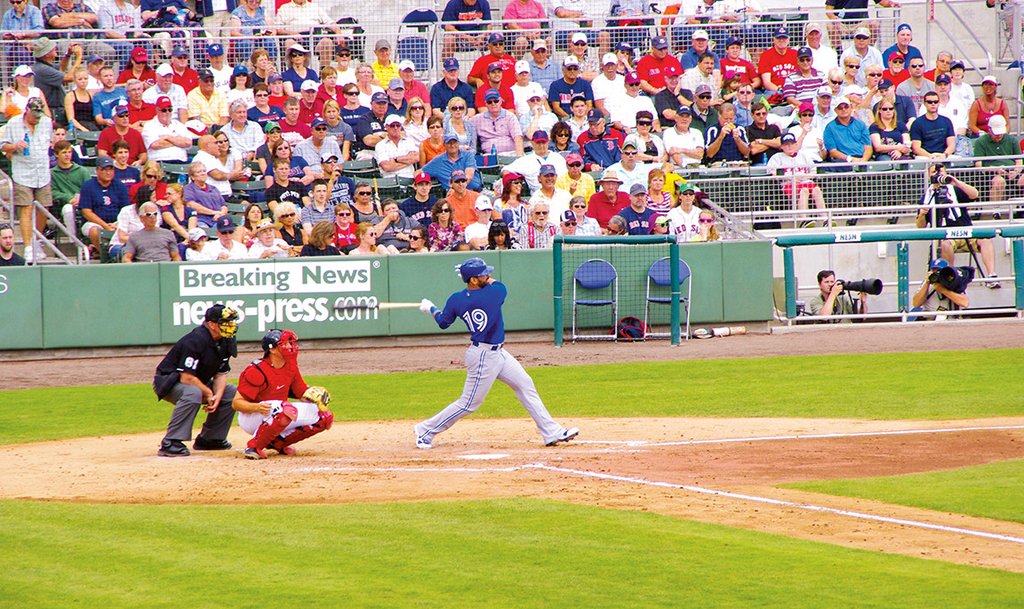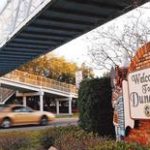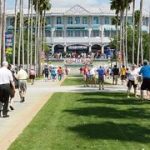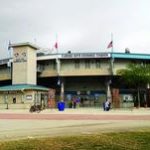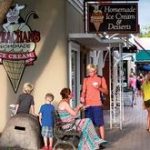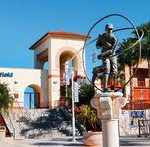FOR A BASEBALL FAN, THIS IS A DREAM VACATION
By Rob & Wendy Lindsay
It doesn’t get much better than this for baseball fans—warm sunshine far from snowy driveways, a hot dog in one hand and cold beverage in the other, and the Blue Jays jogging onto the field. The ballpark is much smaller and more intimate than Toronto’s Rogers Centre and you feel closer to the action. The sky is blue and the grass—the real thing, carefully manicured in a pattern—is green. Across the outfield, the Maple Leaf flutters next to the Stars and Stripes beside a row of gently swaying palm trees.
This is spring training. At these winter baseball games, the atmosphere is more relaxed and casual—both on and off the field. It’s not unusual to see a runner chatting away with the first baseman as if they haven’t seen each other for months, which they probably haven’t. They might even have played for the same team last season. Here’s a chance for a fan to see the team’s new lineup for the first time and get a peek at players called up from the minors for a tryout.
Whether you’re taking in Grapefruit League action in Florida or Cactus League games in Arizona, spring training is a great excuse for snowbirds to invite the rest of the family south for a visit. At every game at every ballpark, we’ve enjoyed seeing three generations in their Blue Jays garb. Over the years, many families have told us that they plan their southern visit with Grandma and Grandpa with the spring training schedule in mind, for the tickets are affordable and they can happily take the whole family to a game.
CLOSE TO THE ACTION
Things have changed since we took in our first spring game in Florida in 2004. The Blue Jays were playing the Red Sox in Boston’s former spring home, City of Palms Park in Fort Myers. It was an intimate little park tucked away in a downtown neighbourhood where you paid $5 to park your car on someone’s lawn. The park seated fewer than 8,000 fans and you felt close to the action—if you could get a ticket: most games were sell-outs.
We learned that Boston fans are an enthusiastic bunch, with seats often willed from one generation to the next. That, combined with the ever growing number of snowbirds, meant that it was becoming impossible to get tickets. Scalpers were having a field day.
The solution arrived with great fanfare in 2012, when JetBlue Park opened in Fort Myers. Hailed as an avant-garde combination of new and old, the $80 million winter home of the Red Sox seats 11,000, with about 80 per cent of the seats sheltered by an undulating white metal roof that is ultramodern. Yet the field channels Boston’s vintage Fenway Park, with its original manual scoreboard set within a replica 37-foot (11.3-metre) “Green Monster” left-field wall. In this day of electronic signage, it’s great fun to watch a little door open in the green wall and someone run out with a stepladder and climb up to hang the score. Just as in Boston, fans can even sit on top of the Green Monster; the playing field even has the same dimensions as Fenway’s.
Along Fenway Drive South Concourse, it’s like a big party pre-game, with live music and food vendors offering everything from Fenway franks to Florida seafood. “Fenway South,” as the park is most often called, is more accessible than its parent park in two ways: it’s only two miles (3.2 kilometres) from the interstate (I-75) and it has improved facilities for fans with mobility issues. Parking now costs $12 and golf cart shuttles carry those who decline to walk across the acres of parking. The state-of-the-art rehab and training facility adjacent to the ball field has become the envy of other teams.
Not to be outdone, Lee County Sports Complex and Hammond Stadium, the winter home of the Minnesota Twins, has undergone a two-stage, $48.5 million renovation. Completed in 2015, the facility expanded its seating capacity from 8,000 to 9,300, with the new stadium chairs a comfortable improvement over the metal bench seating of old. Each year at the annual Twins versus Jays game, we’ve noticed more and more Blue Jays caps and shirts among this friendly crowd. The new boardwalk concourse allows fans to walk around above the outfield, where you can stop in left or right field at one of the two new bars or watch from the drink-rail seating in centre field. A retail shop is proving very popular selling Twins clothing to those out for a boardwalk stroll.
For the players, there’s a new residential player-development academy with dormitory, training room, and agility field. Fortunately they didn’t change Hammond’s main entry—you still walk down a palm-lined avenue to a cascading waterfall, above which hangs a huge banner reading “Welcome to Sprint Training.” This popular meeting spot probably appears in more selfies than any other part of Hammond Stadium.
- Welcome to Dunedin
- The palm-lined entry to Hammond Stadium
- Florida Auto Exchange Stadium
- Inside the Florida Auto Exchange Stadium
- Bright House Networks Field, Clearwater, winter home of the Philadelphia Phillies.
Photos: Lindsay Editorial, Adam Gardiner. Visit Florida/Lara Cerri (Strachan’s) and Visit Florida (Dunedin and stadium).
Like all Blue Jays fans, we had to make the pilgrimage to the Jays’ winter home—Florida Auto Exchange Stadium—in Dunedin, a pleasant little town of 37,000 named for Scotland’s capital, Edinburgh (burgh is the English version of the Scots-Gaelic dun, or “fort”). During spring training, the streets near the ballpark are decked out in blue banners and many stores have window signs welcoming Canadians. Everyone seems friendly, from the fellow who encourages you to park on his lawn—for a fee—to the smiling vendors scooping out the famous Strachan’s homemade ice cream for a sea of blue jerseys. On game day, the town is bustling.

Seating 5,509, the modest stadium is one of the smallest in the Grapefruit League. However, many fans enjoy the intimacy of the park and chatting with other Canadians. The current licence agreement between the city of Dunedin and the Blue Jays expires in 2017, and so here, too, there’s talk of expansion and renovation. It’s worth noting that the Blue Jays have called Dunedin their spring-training home since 1977, and that they’re the only major league franchise never to have changed spring-training cities. It appears that both parties are inclined to extend their 40-year relationship.
The city of Dunedin and the Jays had hoped to find a new piece of land to accommodate both a new stadium and a rehab facility, but none seems to be available, so renovations of the old sites are under consideration. Interestingly, the architectural firm involved is Populous—the same firm that designed many ballparks, including JetBlue and Hammond.
THE CACTUS LEAGUE
You can enjoy spring training baseball whether your winter getaway takes you to Florida or Arizona.
Florida’s Grapefruit League has 15 teams in 14 locations—with Fort Myers on the west coast and Jupiter on the east coast each with two teams. The 2017 season marks 128 years of Major League Baseball training in Florida.
In balmy rain-free Arizona, the Cactus League has 15 teams training in 10 locations, but all the baseball parks are within an hour’s drive of one another, scattered in and around metropolitan Phoenix. The Cactus League dates back to 1947, when there were only two teams wintering in Arizona, the Cleveland Indians and the New York Giants.
The newest stadium built for spring training (and also designed by Populous) is Sloan Park in Mesa (dubbed “Wrigleyville West” by fans), which opened in 2014 as the winter home for the Chicago Cubs—the 2016 World Series champions.
The players’ new development centre features a two-storey weight and cardiovascular facility, a hydrotherapy room, a 120-seat theatre, a family waiting room and cafeteria, and locker rooms. The training facility includes 12 covered batting tunnels and two groups of 12-mound bullpens, six full-size practice fields, and one half-size field for infield practice, as well as other specialized training areas. You can be sure all the other teams in both leagues are taking note of the amenities.
TRAVEL TIPS: Thanks to the popularity of spring training baseball, most destinations that host teams have created attractive travel specials. Look for packages that can include perks such as special room rates, game tickets, in-room gifts, ballpark food, clubhouse tours, autograph sessions with players, and shuttles to the ballpark. Tickets: SpringtrainingConnection.com/tickets.html is a good source of information. Ordering online from the team’s winter home website before you leave Canada is a smart idea, as orders are usually accepted and mailed only to the billing address on the associated credit card. Alternately, go to the box office in person and take your chances. Many parks have last-minute berm seating on the grass. High-rivalry games (Yankees versus Red Sox, for example, and anything involving the Chicago Cubs this winter) sell out quickly, often before the season even opens. Best bet: Order tickets early!


